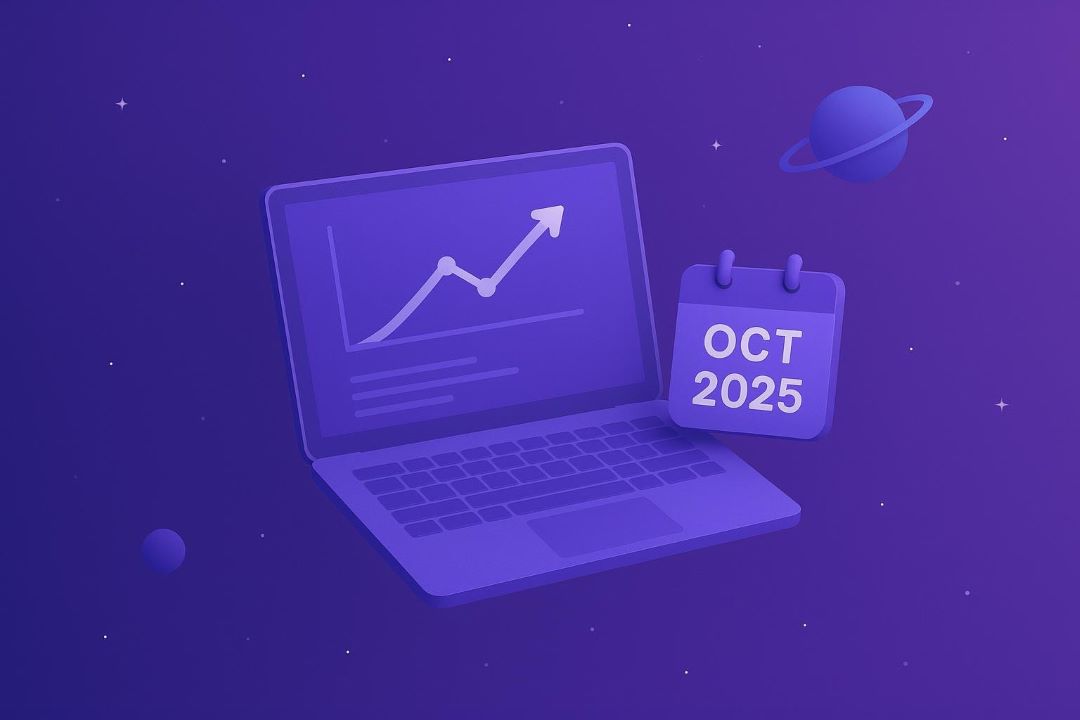Google’s October 2025 algorithm updates bring sweeping change to SEO strategy. Agencies and marketers now face a clear mandate: adapt or risk falling behind. This means success depends on understanding AI-driven search intent and eliminating low-value duplicates. It also involves optimizing content, improving structured data, and enhancing page speed and accessibility.
Gaining momentum starts by addressing how to align your strategy with evolving AI-powered search behavior.
Adapt to Evolving AI Mode Search Intent
Adapting your content for “AI Mode” search intent is now core to keeping organic performance strong. Specifically, Google’s latest update lets users describe what they want in their own words or with photos. AI Mode interprets these requests and displays tailored visual results from over 2 billion listings per hour.
Users interact naturally, searching through visuals rather than typing generic keywords into filters. In addition, the engine recognizes not just primary objects but also subtle details and context within images using advanced multimodal models tied to Gemini 2.5 language technology, as confirmed by TechCrunch. It links each image result so people can act immediately, thereby leading straight to product or resource pages aligned directly with their real wants at that moment.
This means vague concepts quickly turn into shoppable or actionable moments without manual sorting or trial-and-error searches on sites themselves. For brands optimizing website SEO today, speaking plainly and depicting clear intent now matters much more. Google’s ability to match conversational queries makes it essential you anticipate both broad phrases and highly specific user needs upfront.
Strengthen Internal Linking Strategies
Shifts in Google’s core and Penguin updates now target individual pages, not just domains. Strengthening your internal linking is one of the most effective ways to future-proof rankings after algorithm changes.
- Build Contextual Topic Bridges: Structure links between related articles within broad topic clusters. Internal backlinks should connect content that shares search intent or builds topical authority for specific services or keywords. This boosts relevance when tools like CORE AI Analyzer identify areas for additional topical depth.
- Audit and Update Inactive Links Regularly: Outdated links weaken a page’s trust signals under new granular algorithms. Use our actionable roadmap from SEO Mapping to spot broken paths, irrelevant anchor text, or orphaned pages every quarter at minimum. Even tiny tweaks can have measurable impact as Penguin reevaluates these elements continuously.
- Assign Strategic Anchor Texts with Intent: Vary anchors naturally based on user queries and primary keyword targets per page. Avoid using the same phrases repeatedly which could trigger unnatural profile warnings reported by earlier quality-focused updates like Phantom and Panda combined into today’s ranking systems. We pair Keyword AI analysis with human review so each link reads authentic while supporting your broader SEO strategy.
Reduce Low Value Duplicate Pages
Broken links can be frustrating, but duplicate pages bring headaches that last longer. Recent Google algorithm updates are much stricter about low-value and copied content. If your site has repeated or thin pages, even by accident, then these updates will find them fast.
Studies show as much as 30% of indexed web content is duplicated in some form, yet search engines now prioritize unique value first. For example, many e-commerce sites lost rankings for using manufacturer product descriptions more than once across their catalogues this year alone. Routine audits help you uncover weak spots before they cause ranking drops during future rollouts.
Google flags verbose filler text and near-identical AI drafts, so even minor differences may not protect those pages from a dip in visibility. Also, use Search Console to spot underperforming duplicates and review performance data after each update rollout period passes; ignore small variations because the core issue sits with purpose and originality. We recommend merging unnecessary copies into single authoritative resources when possible rather than bloating your crawl budget with surface-level tweaks that do little good long term.
Introduce canonical tags only if absolute consolidation isn’t practical since it tells algorithms which version should count, all while preserving genuine user experience signals favored by new quality guidelines. With SERP volatility sticking around far longer post-update in recent months, every duplicate cutback saves recovery time later if shifts happen again next quarter (and odds say they will). In short: clear out any repetition right now to keep authority intact through unpredictable waves ahead, and always go deeper on substance any time you consider adding something close to what’s live already
Boost Core Web Vitals Scores
Rising volatility since the August 2025 Google algorithm update means even small shifts in Core Web Vitals can impact your rankings. Improving these scores requires you to focus on measurable user experience signals that match Google’s new quality benchmarks.
- Optimize Largest Contentful Paint (LCP): Ensure your main content loads within 2.5 seconds by compressing images, reducing server response times, and prioritizing critical assets.
- Reduce Cumulative Layout Shift (CLS): Stabilize elements on each page so visible layout changes are minimized, which helps lower CLS below the recommended threshold of 0.1.
- Minimize First Input Delay (FID): Limit unnecessary JavaScript and keep third-party scripts lean, as delays over 100 milliseconds reduce both interactivity and usability for real users.
- Monitor with Real-World Data: Leverage Google Search Console or Chrome UX Report to spot timing bottlenecks after recent updates, The Verge recently highlighted these tools’ growing accuracy post-June core update.
Optimize for Helpful Content
Optimizing for helpful content is now essential after Google merged the Helpful Content System into its core ranking in March 2024. Specifically, data from analyses, like those by SEO news publications, show that around 32% of travel publishers lost over 90% of their organic traffic following this update. Affiliate and information-heavy sites were hit hard too, dropping significantly when their pages focused more on search engines than real user value.
Websites with thin or mass-produced articles saw almost all visibility disappear, especially those running “content farms” that lacked depth or originality. Micro-sites sitting on subdomains without careful management found themselves under strict scrutiny as Google cracked down on manipulative strategies instead of rewarding real experience and expertise. To avoid these losses, it’s critical to review every page’s usefulness from a visitor perspective rather than just keyword stuffing or automation shortcuts alone.
If there’s third-party material not directly related to your main site goals, or produced without direct oversight, we recommend blocking indexing so performance won’t tank across your entire domain. We help you build an actionable roadmap centered entirely around relevance, transparency, and human-edited quality that is aligned with Google’s drive toward useful results people actually want to see.
Prioritize Fast Mobile Page Loading
Prioritizing fast mobile page loading has become essential as Google’s mobile-first indexing and Page Experience updates reward speed. Sites that load quickly on smartphones and tablets often see higher rankings, better engagement rates, and stronger retention.
- Optimize Image Sizes: Large images slow down mobile pages dramatically. Always compress images before uploading without losing any obvious quality to the human eye. According to Google Developers, reducing image size alone can decrease page weight by up to 80%. Fast-loading graphics make visitors stick around longer instead of bouncing after a laggy few seconds.
- Streamline Code: Bulky code increases loading times for mobile users in everyday situations like waiting at the bus stop. Minify HTML, CSS, and JavaScript files so browsers render pages rapidly even when networks are spotty or slow. The New York Times Tech section notes developers who streamline their sites see average webpage speed gains of 30% across devices. Every unnecessary element adds wait time visitors notice right away.
- Use Reliable Speed Testing Tools: Fast sites rely on accurate testing rather than gut feelings about performance. Run Google PageSpeed Insights at least monthly and track fixes using its clear improvement list tailored for mobile performance needs. Forbes highlights how brands using PageSpeed score improvements saw conversion lifts over 10%. Incorporating regular checks ensures every update keeps your site quick and enjoyable everywhere your clients go online.
Leverage Structured Data More Effectively
Fast-loading mobile pages are only part of staying visible in Google’s shifting results. However, to stand out in October 2025, structured data must play a bigger role on every site. Structured data is additional code that gives Google clear signals about your content.
Clark, who trains professionals globally on Google tools, often highlights how these details help algorithms better interpret web pages. It’s especially key as algorithm updates make intent matching more granular. In fact, organic search contributes to over 53% of all website traffic, according to multiple industry reports.
By marking up reviews, FAQs, and business details, your content can qualify for richer results like featured snippets and carousels. This means higher click-through rates and more trustworthy visibility as Google’s updates increasingly favor well-annotated pages. With structured data, there’s a clear audit trail that helps us troubleshoot and prove compliance after every major ranking shift.
Improve Image and Video Accessibility
Adding structured data drives deeper context for search, but the October 2025 Google algorithm updates now reward more thorough image and video accessibility on your site. Making your visual assets accessible is now critical, as algorithmic shifts put greater weight on inclusive, user-friendly media.
- Use descriptive alt text for images and videos. Recent studies reported by The New York Times show accessible image descriptions increase engagement by 23%.
- Add accurate, keyword-rich captions to all videos. Captions help not just users with hearing loss but also enhance comprehension and on-page keyword performance.
- Provide transcripts for video and audio content. This allows Google’s AI systems to understand, index, and verify your content with repeatable precision, much like quantum verifiability in scientific experiments.
Focus on User Experience Signals
User experience signals now play a major role in ranking after the latest Google Algorithm Updates. Google carefully tracks metrics like dwell time, bounce rate, and page interaction to decide if your site delivers value. As a result, pages that are cluttered, slow, or tough to navigate usually slip in results.
Optimizing layout, mobile usability, and clear structure keeps visitors engaged and coming back. According to Search Engine Journal, even small tweaks in readability and navigation can reduce bounce rate by up to 15%. Real-world case studies, like the online course platform featured in Wired, show that restructuring pages to add clarity and interactive elements leads to measurable gains in engagement.
Test changes yourself using heatmaps or session recordings to see exactly where visitors lose interest. The bottom line: Google’s new system rewards content people trust, paired with experiences they actually enjoy using. This is the path to compounding your organic growth.
October 2025’s Google updates reinforce the need for agencies and businesses to balance proven strategy with AI-driven tools. Specifically, staying proactive means tracking version changes, auditing site performance, and building topical authority that stands firm through search volatility. At SEO Vendor, we blend human expertise with CORE AI Analyzer to deliver actionable roadmaps, white-label ready, for consistent growth after every algorithm shift.
In addition, invest in both process transparency and ongoing content improvement if you want reliable rankings results backed by clear audit trails and measurable gains over time.









8 comments
Lowell Luna
October 28, 2025 at 1:35 pm
After reviewing this recent change from Google, it’s evident their emphasis is shifting toward rewarding sites with trustworthy authorship signals through consistent brand representation across all digital platforms rather than focusing mainly on traditional optimization methods alone.
Brett Tucker
October 28, 2025 at 2:49 pm
Great article! I really appreciate the clear insights you shared – it shows true expertise.
Margret Steuber
October 28, 2025 at 3:58 pm
The October Google Algorithm Updates highlight the ongoing focus on page quality signals and authentic content creation. Ensuring technical SEO remains strong, while emphasizing real user engagement, will help maintain stable rankings during future search changes
Monica Harris
October 28, 2025 at 6:29 pm
After analyzing multiple client accounts post-update, rich media usage showed significant gains when supporting main topics directly but excess distractions hurt engagement rates; every digital marketer needs regular audits now more than ever given how granular these algorithmic shifts have become
Lou Morrison
October 28, 2025 at 7:14 pm
Many local businesses benefited after Google’s shift favored well-structured schema integration within listings last October; applying these adjustments early helped several campaigns gain new traffic much faster than expected during my quarterly reviews with small business partners
Roy Donaldson
October 28, 2025 at 7:24 pm
I noticed tighter scrutiny of page speed metrics this month following the update’s rollout, sites that improved image compression saw positive movement almost overnight according to Search Console data from retail clients we manage weekly
Kali Friesen
October 29, 2025 at 3:38 am
These updates continue Google’s focus on rewarding helpful, original material while penalizing thin or repetitive sites. Brands should revisit their pages immediately to maintain strong visibility, especially where competition is high in valuable keyword segments
Lois Buchanan
October 30, 2025 at 10:05 pm
The October 2025 Google Algorithm Updates show a clear emphasis on content quality and user experience. Reviewing analytics quickly helps identify any ranking changes, letting marketers adjust strategies for better long-term performance across all search channels.
Comments are closed.